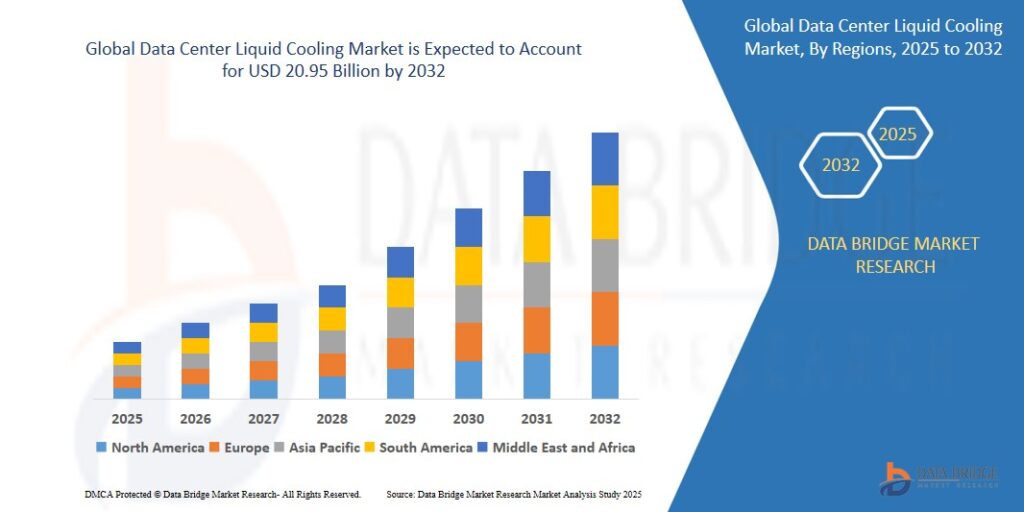
The Data Center Liquid Cooling market was valued at USD 2.82 Billion in 2023 and is expected to reach USD 16.79 Billion by 2031, growing at a CAGR of 24.96% (2024-2031). Get insights on trends, segmentation, and key players with Data Bridge Market Research Reports.
Introduction
As global data consumption continues to skyrocket, data centers are under immense pressure to enhance their efficiency while reducing energy consumption. Traditional air cooling methods are proving insufficient in managing the increasing heat loads generated by modern high-performance computing (HPC) and artificial intelligence (AI) applications. Liquid cooling technology has emerged as a transformative solution, offering enhanced thermal management, lower operational costs, and improved sustainability.
Definition
Data center liquid cooling is a sophisticated thermal management method that dissipates heat produced by servers and other IT equipment using liquids, usually water or a specialized coolant. By effectively transferring heat away from components, liquid cooling can lower overall temperatures and enhance performance, in contrast to typical air cooling, which depends on airflow. This technique may include immersion cooling, in which whole servers are immersed in coolant, or direct-to-chip cooling, in which liquid circulates near heat sources. Liquid cooling is becoming more and more common in contemporary data center designs since it improves energy efficiency, reduces the chance of overheating, and permits higher-density deployments.
The Increasing Demand for Data Center Liquid Cooling
The amount of energy used by data centres has increased. For AI workloads, edge computing, and high-density servers, more effective cooling techniques are needed. Air cooling systems struggle to dissipate heat effectively, leading to higher energy usage and increased operational costs. Liquid cooling, which uses water or dielectric fluids, provides a more efficient alternative by directly absorbing and transferring heat away from critical components.
Emerging Trends in Liquid Cooling Technology
Direct-to-Chip Cooling:
Direct-to-chip cooling is becoming more and more popular as a very effective way to dissipate heat. Through the use of cold plates that come into direct contact with server processors and other heat-producing components, coolant is circulated. Through direct-to-chip cooling, the need for conventional air conditioning is greatly reduced, which lowers energy consumption and enhances system performance.
Immersion Cooling:
Servers and other IT equipment are completely submerged in a heat-absorbing dielectric fluid as part of the novel immersion cooling technique. This method eliminates the need for conventional air cooling and enhances thermal efficiency. Single-phase and two-phase immersion cooling techniques are being explored for their potential to lower energy usage and improve hardware lifespan.
- Single-phase immersion cooling: As heat is being circulated away, the liquid stays in the same state.
- Two-phase immersion cooling: The liquid evaporates upon absorbing heat and then condenses back into a liquid form.
Advanced Coolants and Sustainable Fluids:
Coolants based on mineral oil or water are used in conventional liquid cooling systems. However, the industry is shifting toward more sustainable and environmentally friendly alternatives. Companies are developing bio-based, non-toxic, and biodegradable coolants to minimize environmental impact. Additionally, research into nanofluids-fluids infused with nanoparticles for better thermal conductivity-is opening new possibilities for efficiency improvements.
Hybrid Cooling Systems:
Hybrid cooling solutions, which integrate liquid cooling with traditional air cooling, are becoming increasingly popular. These systems use liquid cooling for high-density servers to optimize heat management while maintaining air cooling for less heat-intensive components. Hybrid approaches help data centers transition from air to liquid cooling without requiring a complete infrastructure overhaul.
AI-Driven Cooling Optimization:
Artificial intelligence and machine learning are playing a significant role in optimizing liquid cooling efficiency. AI-powered systems are able to dynamically modify cooling parameters by analysing temperature sensor data in real time. This ensures that cooling resources are utilized effectively, reducing energy waste and enhancing system reliability.
Innovations Shaping the Future of Liquid Cooling
3D Printed Cooling Components:
The use of 3D printing technology in developing customized cooling solutions is revolutionizing data center design. 3D-printed heat exchangers, cold plates, and manifolds allow for intricate and efficient cooling structures, improving overall system performance and flexibility.
Microchannel Cooling Technology:
Microchannel cooling involves the use of tiny channels within cold plates to enhance heat transfer. These technologies increase the surface area available for heat dissipation, resulting in better thermal management. This innovation is particularly beneficial for HPC and AI workloads, where maintaining optimal temperatures is crucial.
Self-Healing Coolant Systems:
Future liquid cooling systems might have self-healing features, in which coolant formulations contain chemical compounds or nanoparticles that can fix small leaks and stop system malfunctions. Such innovations could significantly enhance system reliability and longevity.
Modular and Scalable Cooling Solutions:
Modular liquid cooling systems are emerging to address the growing need for scalability. These solutions allow data centers to implement cooling upgrades without disrupting operations, enabling businesses to scale their cooling infrastructure as demands increase.
Liquid Cooling in Edge Data Centers:
Liquid cooling is being used in smaller, dispersed data centres as edge computing becomes more popular. Edge data centers require efficient cooling solutions to manage heat loads in compact spaces, making liquid cooling a viable option for ensuring reliability in distributed computing environments.
Benefits of Liquid Cooling Technology
- Energy Efficiency: Overall energy consumption is decreased because liquid cooling uses less power than conventional air cooling.
- Lower Operational Costs: By enhancing cooling efficiency, liquid cooling helps lower electricity and maintenance costs.
- Improved Performance: Maintaining lower and more stable operating temperatures leads to enhanced hardware performance and longevity.
- Space Optimization: Liquid cooling reduces the need for bulky air conditioning units, allowing for higher server density in data centers.
- Sustainability: Advanced cooling fluids and efficient heat dissipation methods contribute to greener and more sustainable data center operations.
Challenges and Considerations
Despite its advantages, liquid cooling presents certain challenges:
- Initial Cost: Implementing liquid cooling systems requires a significant upfront investment.
- Complexity: Integrating liquid cooling into existing infrastructure may require specialized expertise and modifications.
- Leakage Risks: Proper system design and maintenance are necessary to prevent leaks that could damage sensitive equipment.
- Standardization Issues: The lack of universal standards for liquid cooling components and coolants poses integration challenges.
The Future of Data Center Cooling
Data center liquid cooling is expected to undergo a swift evolution in the future due to the growing need for high-performance and energy-efficient computing systems. Further cementing liquid cooling as a common solution will require scalable designs, AI-driven cooling optimisations, and ongoing material breakthroughs. Moreover, as regulatory pressures for sustainability increase, data centers will likely embrace liquid cooling as a key strategy for reducing their environmental footprint.
Growth Rate of Data Center Liquid Cooling Market
According to Data Bridge Market Research, with a compound annual growth rate (CAGR) of 24.96% from 2024 to 2031, the data center liquid cooling market is projected to reach USD 16.79 billion from its estimated USD 2.82 billion in 2023.
Read More: https://www.databridgemarketresearch.com/reports/global-data-center-liquid-cooling-market
Conclusion
Liquid cooling technology is transforming the data center landscape by providing an efficient, scalable, and sustainable solution for managing heat loads. With innovations such as direct-to-chip cooling, immersion cooling, AI-driven optimization, and advanced coolants, the future of data center cooling looks promising. While challenges remain, ongoing research and development efforts are paving the way for broader adoption and enhanced efficiency. As data centers continue to evolve, liquid cooling will play a crucial role in ensuring their performance, reliability, and environmental sustainability.







